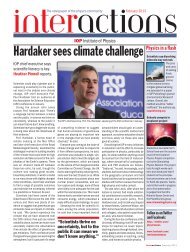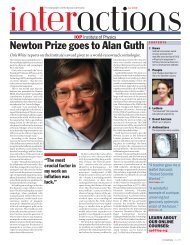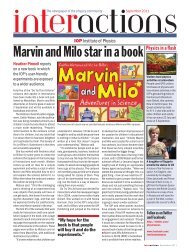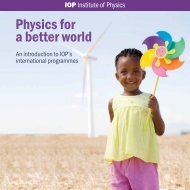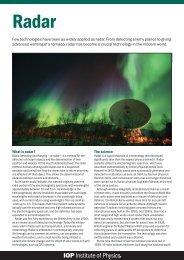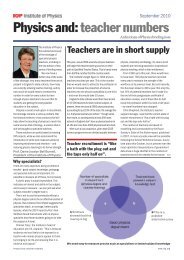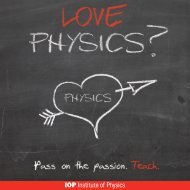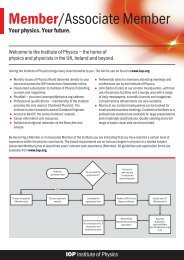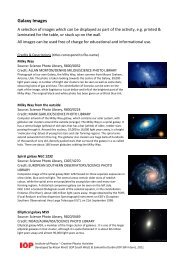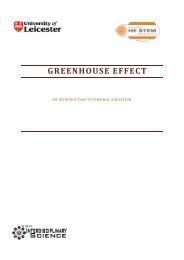Girls in the Physics Classroom: A Teachers' Guide - Institute of Physics
Girls in the Physics Classroom: A Teachers' Guide - Institute of Physics
Girls in the Physics Classroom: A Teachers' Guide - Institute of Physics
You also want an ePaper? Increase the reach of your titles
YUMPU automatically turns print PDFs into web optimized ePapers that Google loves.
1: Lessons from effective classroom practice<br />
8<br />
pl<strong>in</strong>es – probably than all o<strong>the</strong>r school subjects apart from<br />
ma<strong>the</strong>matics. Most physics teachers are steeped <strong>in</strong> <strong>the</strong><br />
use <strong>of</strong>, and sometimes <strong>the</strong> abuse <strong>of</strong>, this type <strong>of</strong> language.<br />
For example, it is not uncommon to hear “V = IR” used to<br />
denote Ohm’s law. For many pupils – boys and girls – this<br />
use <strong>of</strong> language and symbols is mystify<strong>in</strong>g and it re<strong>in</strong>forces<br />
<strong>the</strong> impression that <strong>the</strong> subject does not connect with <strong>the</strong>ir<br />
world. Teachers who “talk equations” at an early stage <strong>in</strong><br />
physics education risk alienat<strong>in</strong>g many students – girls <strong>in</strong><br />
particular – from <strong>the</strong> subject.<br />
Pupils’ responses to questionnaires as part <strong>of</strong><br />
Ponchaud’s <strong>in</strong>vestigation showed that <strong>the</strong>y closely l<strong>in</strong>ked<br />
physics with ma<strong>the</strong>matics from <strong>the</strong> start <strong>of</strong> KS4. Discussion<br />
with students revealed that <strong>the</strong>y made this l<strong>in</strong>k not because<br />
<strong>of</strong> <strong>the</strong> use <strong>of</strong> numbers but because <strong>of</strong> <strong>the</strong> algebraic symbols<br />
and words used to represent concepts that <strong>the</strong>y had<br />
not fully grasped.<br />
“It’s all about remember<strong>in</strong>g equations. I can<br />
work out <strong>the</strong> resistance <strong>of</strong> a wire but I don’t<br />
know what it means.”<br />
<strong>Girls</strong> especially found that this was a problem because<br />
<strong>the</strong>y felt unable to “ask questions about a word or equation”<br />
and so felt that <strong>the</strong>ir understand<strong>in</strong>g was stalled.<br />
Teachers who only <strong>in</strong>troduced equations once <strong>the</strong> underly<strong>in</strong>g<br />
concepts were well established were able to keep girls’<br />
<strong>in</strong>terest for longer. The use <strong>of</strong> technical language and equations<br />
out <strong>of</strong> context was greater <strong>in</strong> most <strong>of</strong> <strong>the</strong> mixed classes<br />
that were observed than <strong>in</strong> <strong>the</strong> girls-only groups. On <strong>the</strong><br />
whole, boys appeared happy with <strong>the</strong> technical language<br />
and algebraic shorthand because <strong>the</strong>ir use conferred status.<br />
The boys responded to questions that were terse and<br />
<strong>of</strong>ten used similar language <strong>in</strong> reply. Many girls appeared<br />
uncomfortable with this form <strong>of</strong> communication and held<br />
back from respond<strong>in</strong>g, even when it was evident that <strong>the</strong>ir<br />
understand<strong>in</strong>g was as good as that <strong>of</strong> many <strong>of</strong> <strong>the</strong> boys.<br />
Teachers, both male and female, <strong>in</strong> <strong>the</strong> most successful<br />
schools made more spar<strong>in</strong>g use <strong>of</strong> technical language,<br />
used term<strong>in</strong>ology <strong>in</strong> context and avoided algebraic shorthand.<br />
They used everyday language wherever possible and,<br />
where term<strong>in</strong>ology was needed, it was carefully def<strong>in</strong>ed<br />
and pupils’ understand<strong>in</strong>g was checked. Wherever possible,<br />
pupils were encouraged to use <strong>the</strong>ir own words to<br />
describe observations or properties, such as us<strong>in</strong>g “squeezability”<br />
<strong>in</strong>stead <strong>of</strong> compression. The guid<strong>in</strong>g pr<strong>in</strong>ciple was<br />
to establish ideas and concepts before <strong>the</strong> use <strong>of</strong> term<strong>in</strong>ology<br />
or equations. Pupils were <strong>the</strong>n encouraged to use<br />
<strong>the</strong> essential terms correctly and <strong>in</strong> context. This did not<br />
reduce <strong>the</strong> demand <strong>of</strong> <strong>the</strong> work. In fact, <strong>the</strong> more careful<br />
use <strong>of</strong> language was <strong>of</strong>ten more rigorous.<br />
At <strong>the</strong> start <strong>of</strong> <strong>the</strong> lesson, electricity was <strong>in</strong>troduced <strong>in</strong><br />
an entirely non-technical way. Groups <strong>of</strong> pupils discuss<br />
questions such as “What is it about electricity that makes<br />
it so useful to us?”; “What happens when we turn a light<br />
switch <strong>of</strong>f?”; “Why do we have to have a system <strong>of</strong> pylons<br />
and cables around <strong>the</strong> country?”; and “Why can’t we<br />
store electricity?” The <strong>in</strong>troduction <strong>of</strong> terms such as<br />
”current” and “voltage” were <strong>the</strong>n viewed as useful and<br />
<strong>the</strong> l<strong>in</strong>k with energy transfer was clear. Boys wanted to<br />
“get on with mak<strong>in</strong>g circuits” but <strong>the</strong> girls appreciated<br />
hav<strong>in</strong>g a rationale for <strong>the</strong>se activities.<br />
In classes where <strong>the</strong> use <strong>of</strong> technical vocabulary was<br />
m<strong>in</strong>imised <strong>the</strong>re was <strong>of</strong>ten more discussion between girls<br />
about <strong>the</strong> work <strong>in</strong> hand. The removal <strong>of</strong> <strong>the</strong> perceived need<br />
to use jargon liberated <strong>the</strong> pupils and encouraged mutual<br />
support <strong>in</strong> learn<strong>in</strong>g. This led to questions be<strong>in</strong>g asked on<br />
behalf <strong>of</strong> a group <strong>in</strong> order to check <strong>the</strong> consensual view<br />
arrived at through discussion. Postpon<strong>in</strong>g <strong>the</strong> use <strong>of</strong> term<strong>in</strong>ology<br />
until <strong>the</strong> ideas represented were well established<br />
encouraged girls to talk more about <strong>the</strong> work and to ask<br />
questions to aid <strong>the</strong>ir understand<strong>in</strong>g.One girl put it:<br />
“If physics is relevant <strong>the</strong>n we ought to be able<br />
to talk about it us<strong>in</strong>g normal language. I used<br />
not to ask questions because I didn’t know how<br />
to put <strong>the</strong>m – I didn’t have <strong>the</strong> right words.<br />
[Teacher X] doesn’t m<strong>in</strong>d this and encourages<br />
us to have a go. If we use <strong>the</strong> wrong words<br />
[Teacher X] doesn’t correct us or make us feel<br />
embarrassed.”<br />
Messages for practice<br />
● Don’t use non-essential technical language or<br />
formulae as a shorthand for <strong>the</strong> physical laws dur<strong>in</strong>g<br />
<strong>the</strong> early stages <strong>of</strong> learn<strong>in</strong>g.<br />
● Use pupils’ own everyday language as far as possible<br />
and encourage <strong>the</strong>m to do <strong>the</strong> same until concepts are<br />
well established.<br />
● Ensure that essential term<strong>in</strong>ology is clearly def<strong>in</strong>ed<br />
and used <strong>in</strong> context and that understand<strong>in</strong>g is<br />
checked.<br />
● Re<strong>in</strong>force underly<strong>in</strong>g physical pr<strong>in</strong>ciples first ra<strong>the</strong>r<br />
than start<strong>in</strong>g with formulae.<br />
1.6 The use <strong>of</strong> analogy and illustration<br />
How can teachers help pupils – girls <strong>in</strong> particular – to<br />
have appropriate mental pictures <strong>of</strong> ideas <strong>in</strong> physics<br />
and how <strong>the</strong>se relate to <strong>the</strong> observable world?<br />
Given <strong>the</strong> abstract nature <strong>of</strong> physics, analogies and illustrations<br />
can frequently play a vital part <strong>in</strong> giv<strong>in</strong>g structure<br />
to pupils’ learn<strong>in</strong>g. However, many teachers are cautious<br />
about us<strong>in</strong>g analogies, be<strong>in</strong>g aware that <strong>the</strong>y have <strong>the</strong><br />
potential to re<strong>in</strong>force misconceptions. Illustrations are helpful<br />
only if <strong>the</strong>y connect with pupils’ experience and <strong>in</strong>terests.<br />
Most teachers naturally use <strong>the</strong> analogies and<br />
illustrations that <strong>the</strong>y found helpful and relevant dur<strong>in</strong>g <strong>the</strong>ir<br />
own studies, but <strong>the</strong>re is a danger that <strong>the</strong>se are not appropriate<br />
for today’s learners. Many <strong>of</strong> <strong>the</strong>se depictions also<br />
have a gender bias, such as mechanical- or football-related<br />
illustrations. Some girls may be <strong>in</strong>terested <strong>in</strong> football just as<br />
some boys may not, but it is important to use a range <strong>of</strong><br />
I NSTITUTE OF P HYSICS R EPORT G IRLS IN THE P HYSICS C LASSROOM: A TEACHERS’ GUIDE FOR A CTION D ECEMBER 2006




